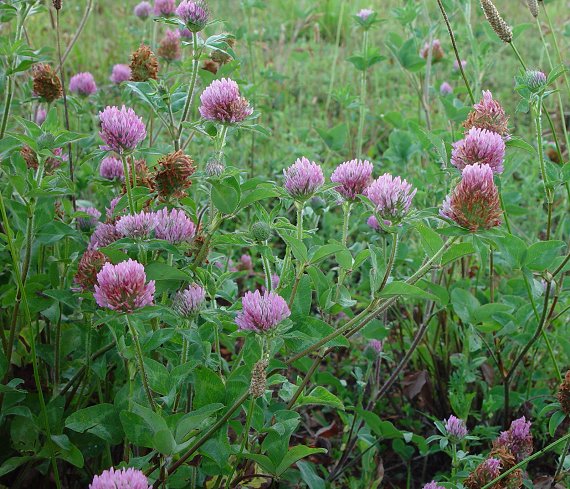Trifolium pratense L.
Red Clover

Introduced
CC = *
CW = 3
MOC = 81
© DETenaglia
Trifolium pratense L.Red Clover | |
 |
Introduced CC = * CW = 3 MOC = 81 |
© DETenaglia |
|
Family - Fabaceae/Faboideae Habit - Perennial forb with a short, stout rootstock. Stems - Ascending to erect, sometimes sprawling, to 60 cm, much-branched, glabrous or with appressed to spreading hairs.
Leaves - Alternate, trifoliate, stipulate, long-petiolate toward the stem base to nearly sessile toward the tip, the longest petioles to 80 mm, 3-4 times the length of the leaflets. Stipules much shorter than to about as long as the associated petiole, ovate to lanceolate, fused more than 2/3 of the way to the tips, the free portions short-tapered to long slender tips, pale with dark green to red veins, the margins usually entire. Leaflets 10-30 mm long, 7-15 mm wide, all sessile or nearly so, ovate to elliptic or obovate, broadly angled at the base, rounded or rarely minutely notched at the tip, usually with a minute broad tooth at the very tip, the margins minutely irregular or inconspicuously and broadly scalloped or toothed, often only near the tip, the surfaces glabrous or sparsely to moderately appressed-hairy. Leaflets sometimes with a chevron-shaped marking in the center.
Inflorescence - Terminal globose cluster 10-30 mm long and wide, sessile or the stalk 1-4 mm (closely subtended by a pair of bractlike leaves). Flowers 40-150, sessile, ascending to spreading at fruiting.
Flowers - Calyces 5-8 mm long, the tube 2.5-4.0 mm long, sparsely to moderately hairy, the teeth narrowly triangular to nearly linear, unequal, the lowest tooth about as long as the tube, the others nearly equal and much shorter, moderately hairy, lacking a prominent network of nerves and not becoming inflated at fruiting. Corollas papilionaceous, 11-18 mm long, longer than the calyx lobes, usually reddish purple, the banner outcurved, oblong-oblanceolate, shallowly notched at the tip, inconspicuously nerved. Standard to 1 cm long, 3-4 mm broad. Stamens diadelphous. Style to 7 mm long, glabrous.
Fruits - Legumes, encased in persistent corolla and calyx, 2-3 mm long, oblong-obovoid, sessile, the outer wall membranous below a well-defined somewhat hardened shiny apical region, brownish-yellow, 1 or 2-seeded. Seeds 1.5-2.0 mm long, ovoid to slightly kidney-shaped, tan to brown, dull. Flowering - April - October. Habitat - Prairies, glades, fields, pastures, lawns, roadsides, railroads, open disturbed areas. Origin - Native to Eurasia. Lookalikes - None in Missouri, though T. hirtum, which is somewhat similar in appearance, occurs in some neighboring states and may eventually appear in Missouri. Other info. - If you live in Missouri you have seen this plant. It it common throughout the state as well as most of the continental U.S. The large pink flower heads and (sometimes) the distinctly marked leaflets are unmistakable. It is an extremely important forage crop and has been cultivated since about the third century. It was present in North America by the late 1600s. Photographs taken in Eminence, MO., 6-6-03, and in Springfield, MO., 7-5-03 (DETenaglia); also at Shaw Nature Reserve, Franklin County, MO, 5-9-2007, and near Labadie, Franklin County, MO, 5-15-2020 (SRTurner). |